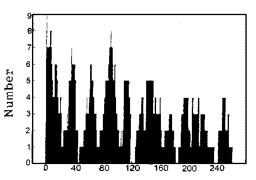 |
Science Frontiers ONLINE No. 87: May-Jun 1993 |
|
|
Whence the earth's pulse?
Geological history records a restless planet subject to a succession of chemical and physical upheavals. Have these great paroxysms been random in time? M.R. Rampino and K. Caldeira do not think so:
 Number of geological events during geologic time |
"Published data sets of major geologic events of the past 250 Myr (extinction events, sea-level lows, continental flood-basalt eruptions, mountain-building events, abrupt changes in sea-floor spreading, ocean-anoxic and blackshale events and the largest evaporite deposits) have been synthesized (with estimated errors). These events show evidence for a statistically significant periodic component with an underlying periodicity, formally equal to 26.6 Myr, and a recent maximum, close to the present time. The cycle may not be strictly periodic, but a periodicity of 30 Myr is robust to probable errors in dating of the geologic events."
The obvious question is: What could cause a 30-million-year periodicity? Internally, the earth's innards might be periodic, possibly in terms of plume eruption, mineral phase changes, core convection, etc. Externally, comets and asteroids are cyclic. Rampino and Caldeira point out that the solar system crosses the heavily populated plane of the Galaxy every 30 million years.
(Rampino, Michael R., and Caldeira, Ken; "Major Episodes of Geologic Change: Correlations, Time Structure and Possible Causes," Earth and Planetary Sci ence Letters, 114:215, 1993.)
Reference. We catalog crater periodicity in ETC4 in Carolina Bays, Mima Mounds. This catalog described here.